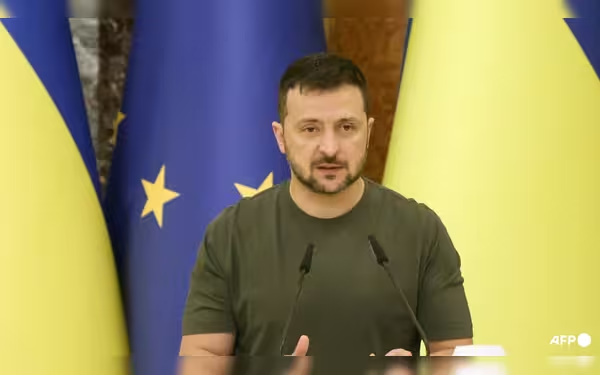Saturday, November 16, 2024 03:19 PM
EU Loans 35 Billion Euros to Ukraine Backed by Frozen Russian Assets
- EU to lend Ukraine €35 billion for economic support.
- Loan backed by frozen Russian assets within the EU.
- G7 nations aim to provide total US$50 billion in loans.
 Image Credits: channelnewsasia
Image Credits: channelnewsasiaThe EU plans to lend Ukraine €35 billion, backed by frozen Russian assets, to support its economy during winter.
In a significant move to support Ukraine amidst ongoing challenges, the European Union (EU) has announced plans to lend the country €35 billion (approximately US$39 billion). This financial assistance will be backed by the revenues generated from Russian assets that have been frozen within the EU. European Commission chief Ursula von der Leyen made this announcement during a visit to Kyiv, where she spoke alongside Ukrainian President Volodymyr Zelenskyy.
Von der Leyen expressed confidence in the swift delivery of this loan, stating, "We are now confident that we can deliver this loan to Ukraine very quickly, a loan that is backed by the windfall profits from immobilised Russian assets." This financial support is crucial for Ukraine, which is striving to stabilize its economy and maintain its electricity grid during the harsh winter months, especially after enduring severe bombardments from Russian forces.
The EU's proposal is part of a broader strategy agreed upon by G7 nations in June, which aims to utilize the proceeds from frozen Russian assets to provide a total of US$50 billion in loans to Ukraine. Von der Leyen also indicated that she believes other G7 countries, including the United States, will contribute their share to this initiative.
Currently, the EU has frozen approximately US$235 billion of Russian central bank funds since the onset of the invasion in 2022. This amount represents a significant portion of immobilised Russian assets globally, with around 90 percent of these funds held by Euroclear, an international deposit organization based in Belgium.
The G7 plan is designed to leverage these frozen assets to generate additional funds for Ukraine, replacing an earlier EU scheme that had already provided US$1.7 billion to Kyiv in July. However, the implementation of the G7 loan has faced delays, primarily due to the United States seeking assurances that the Russian assets would remain frozen. Currently, EU member states must agree every six months to extend this asset freeze, but there are discussions to extend this period to 36 months.
Despite these challenges, the EU has decided to proceed with its portion of the G7 loan, believing that the frozen assets provide sufficient guarantees for the financial support. This decision reflects a commitment to assist Ukraine during a critical time.
The EU's plan to lend €35 billion to Ukraine, backed by frozen Russian assets, represents a vital step in supporting the country as it navigates through a difficult winter. This financial aid not only aims to bolster Ukraine's economy but also underscores the international community's resolve to stand by Ukraine in its time of need. As the situation evolves, it will be essential for all parties involved to ensure that the necessary support continues to flow to Ukraine, helping it to rebuild and recover from the ongoing conflict.













